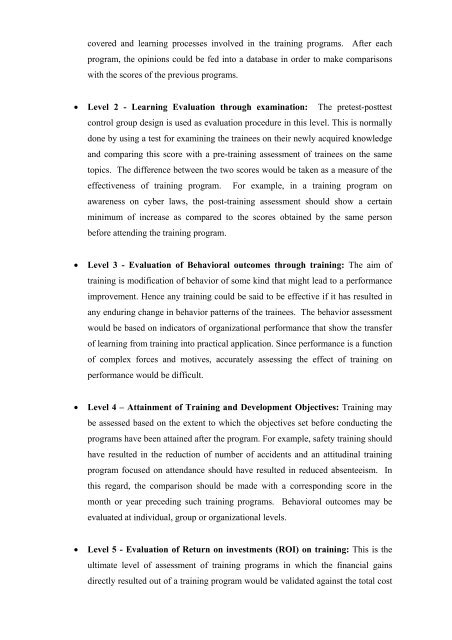UNIT – I Lesson 1 HRM – AN OVERVIEW Lesson Outline Nature of ...
UNIT – I Lesson 1 HRM – AN OVERVIEW Lesson Outline Nature of ...
UNIT – I Lesson 1 HRM – AN OVERVIEW Lesson Outline Nature of ...
Create successful ePaper yourself
Turn your PDF publications into a flip-book with our unique Google optimized e-Paper software.
covered and learning processes involved in the training programs. After each<br />
program, the opinions could be fed into a database in order to make comparisons<br />
with the scores <strong>of</strong> the previous programs.<br />
• Level 2 - Learning Evaluation through examination: The pretest-posttest<br />
control group design is used as evaluation procedure in this level. This is normally<br />
done by using a test for examining the trainees on their newly acquired knowledge<br />
and comparing this score with a pre-training assessment <strong>of</strong> trainees on the same<br />
topics. The difference between the two scores would be taken as a measure <strong>of</strong> the<br />
effectiveness <strong>of</strong> training program. For example, in a training program on<br />
awareness on cyber laws, the post-training assessment should show a certain<br />
minimum <strong>of</strong> increase as compared to the scores obtained by the same person<br />
before attending the training program.<br />
• Level 3 - Evaluation <strong>of</strong> Behavioral outcomes through training: The aim <strong>of</strong><br />
training is modification <strong>of</strong> behavior <strong>of</strong> some kind that might lead to a performance<br />
improvement. Hence any training could be said to be effective if it has resulted in<br />
any enduring change in behavior patterns <strong>of</strong> the trainees. The behavior assessment<br />
would be based on indicators <strong>of</strong> organizational performance that show the transfer<br />
<strong>of</strong> learning from training into practical application. Since performance is a function<br />
<strong>of</strong> complex forces and motives, accurately assessing the effect <strong>of</strong> training on<br />
performance would be difficult.<br />
• Level 4 <strong>–</strong> Attainment <strong>of</strong> Training and Development Objectives: Training may<br />
be assessed based on the extent to which the objectives set before conducting the<br />
programs have been attained after the program. For example, safety training should<br />
have resulted in the reduction <strong>of</strong> number <strong>of</strong> accidents and an attitudinal training<br />
program focused on attendance should have resulted in reduced absenteeism. In<br />
this regard, the comparison should be made with a corresponding score in the<br />
month or year preceding such training programs. Behavioral outcomes may be<br />
evaluated at individual, group or organizational levels.<br />
• Level 5 - Evaluation <strong>of</strong> Return on investments (ROI) on training: This is the<br />
ultimate level <strong>of</strong> assessment <strong>of</strong> training programs in which the financial gains<br />
directly resulted out <strong>of</strong> a training program would be validated against the total cost
















